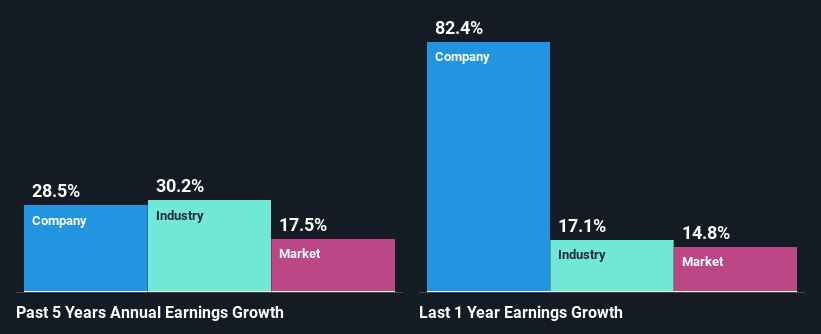Stock Analysis
- India
- /
- Electronic Equipment and Components
- /
- NSEI:DLINKINDIA
Is D-Link (India) Limited's (NSE:DLINKINDIA) Latest Stock Performance A Reflection Of Its Financial Health?

D-Link (India)'s (NSE:DLINKINDIA) stock is up by a considerable 35% over the past three months. Given the company's impressive performance, we decided to study its financial indicators more closely as a company's financial health over the long-term usually dictates market outcomes. Specifically, we decided to study D-Link (India)'s ROE in this article.
Return on Equity or ROE is a test of how effectively a company is growing its value and managing investors’ money. In simpler terms, it measures the profitability of a company in relation to shareholder's equity.
Check out our latest analysis for D-Link (India)
How To Calculate Return On Equity?
Return on equity can be calculated by using the formula:
Return on Equity = Net Profit (from continuing operations) ÷ Shareholders' Equity
So, based on the above formula, the ROE for D-Link (India) is:
24% = ₹911m ÷ ₹3.8b (Based on the trailing twelve months to June 2023).
The 'return' is the profit over the last twelve months. So, this means that for every ₹1 of its shareholder's investments, the company generates a profit of ₹0.24.
What Has ROE Got To Do With Earnings Growth?
Thus far, we have learned that ROE measures how efficiently a company is generating its profits. Depending on how much of these profits the company reinvests or "retains", and how effectively it does so, we are then able to assess a company’s earnings growth potential. Assuming all else is equal, companies that have both a higher return on equity and higher profit retention are usually the ones that have a higher growth rate when compared to companies that don't have the same features.
D-Link (India)'s Earnings Growth And 24% ROE
To begin with, D-Link (India) seems to have a respectable ROE. Further, the company's ROE compares quite favorably to the industry average of 11%. This probably laid the ground for D-Link (India)'s significant 29% net income growth seen over the past five years. We reckon that there could also be other factors at play here. For example, it is possible that the company's management has made some good strategic decisions, or that the company has a low payout ratio.
We then performed a comparison between D-Link (India)'s net income growth with the industry, which revealed that the company's growth is similar to the average industry growth of 30% in the same 5-year period.

The basis for attaching value to a company is, to a great extent, tied to its earnings growth. It’s important for an investor to know whether the market has priced in the company's expected earnings growth (or decline). By doing so, they will have an idea if the stock is headed into clear blue waters or if swampy waters await. Is D-Link (India) fairly valued compared to other companies? These 3 valuation measures might help you decide.
Is D-Link (India) Making Efficient Use Of Its Profits?
D-Link (India)'s three-year median payout ratio to shareholders is 20%, which is quite low. This implies that the company is retaining 80% of its profits. So it seems like the management is reinvesting profits heavily to grow its business and this reflects in its earnings growth number.
Additionally, D-Link (India) has paid dividends over a period of at least ten years which means that the company is pretty serious about sharing its profits with shareholders.
Conclusion
Overall, we are quite pleased with D-Link (India)'s performance. In particular, it's great to see that the company is investing heavily into its business and along with a high rate of return, that has resulted in a sizeable growth in its earnings. If the company continues to grow its earnings the way it has, that could have a positive impact on its share price given how earnings per share influence long-term share prices. Not to forget, share price outcomes are also dependent on the potential risks a company may face. So it is important for investors to be aware of the risks involved in the business. To know the 1 risk we have identified for D-Link (India) visit our risks dashboard for free.
Valuation is complex, but we're helping make it simple.
Find out whether D-Link (India) is potentially over or undervalued by checking out our comprehensive analysis, which includes fair value estimates, risks and warnings, dividends, insider transactions and financial health.
View the Free AnalysisHave feedback on this article? Concerned about the content? Get in touch with us directly. Alternatively, email editorial-team (at) simplywallst.com.
This article by Simply Wall St is general in nature. We provide commentary based on historical data and analyst forecasts only using an unbiased methodology and our articles are not intended to be financial advice. It does not constitute a recommendation to buy or sell any stock, and does not take account of your objectives, or your financial situation. We aim to bring you long-term focused analysis driven by fundamental data. Note that our analysis may not factor in the latest price-sensitive company announcements or qualitative material. Simply Wall St has no position in any stocks mentioned.
About NSEI:DLINKINDIA
D-Link (India)
D-Link (India) Limited markets and distributes D-Link branded networking products for consumers, small businesses, medium to large-sized enterprises, and service providers in India.
Excellent balance sheet established dividend payer.

